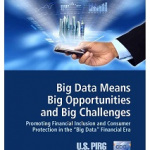
Big Data Means Big Opportunities and Big Challenges
Promoting Financial Inclusion and Consumer Protection in the “Big Data” Financial Era
This report examines the growing use of "Big Data" in financial decision-making, especially in a digital marketplace characterized more and more by the use of mobile phones. It explains the opportunities to use Big Data to promote financial opportunity and the threat of financial exclusion, discrimination or higher prices for some consumers if Big Data is not used properly. The report makes recommendations to advocates, industry and regulators.
Downloads
U.S. PIRG Education Fund and Center for Digital Democracy

From The Introduction
Dramatic changes are transforming the U.S. financial marketplace. Far-reaching capabilities of “Big-Data” processing that gather, analyze, predict, and make instantaneous decisions about an individual; technological innovation spurring new and competitive financial products; the rapid adoption of the mobile phone as the principal online device; and advances in e-commerce and marketing that change the way we shop and buy, are creating a new landscape that holds both potential promise and risks for economically vulnerable Americans.[i] Using advances in data analytics specifically to promote economic inclusion and fairness during this period of transformation in the U.S. economy should be a proactive strategy embraced by all stakeholders. While not a panacea to address growing financial inequality, a wise investment in strategies that harvest the potential of the new digital financial system may better enable struggling Americans to maneuver a difficult economic future.
It is also possible, however, that the emergence of a powerful data-driven “Banking 3.0,” (as it is sometimes called), and the shift to a digital and mobile services financial system, could provide further obstacles to the consumers most at risk today—imposing new forms of unaffordable loans, discriminatory pricing, escalating fees for services, and unfair marketing practices. […]
But beyond the grim statistics and the heart-breaking daily struggles that so many face, there is also the glimmer of a potential opportunity. Underbanked and unbanked Americans are not totally cut off from the changes that are reshaping financial services. In fact, they can help to influence its direction and growth. Digital services—especially mobile phones—play an extraordinary role in how the new financial services marketplace delivers products and services for banking, credit, shopping, and more. Many lower income and other consumers already rely on mobile phones to access the Internet (illustrating the realities of the “digital divide” that makes wireline-based broadband connections out of reach).[ii] Nearly 90 percent of underbanked consumers have mobile phones; more than half have “smart phones.” Nearly half of the underbanked already use their mobile phones for banking services.[iii] […]
As the marketplace looks to define “best” mobile marketing practices, as regulators seek to establish rules and guidelines, and as the financial and other digital industry sectors seek to build new markets (such as “hyper-local” targeted online advertising), ensuring that economically vulnerable Americans benefit should be a strategic goal during this transition period.
This report is intended to provide an overview of key issues for policymakers, thought leaders, and others concerned about financial inclusion and economic opportunity. The authors hope that its recommendations for further research, engagement, and outreach provide guidelines for next steps.
Where Do We Go from Here?
The Need for Public Education, Transparency, and Advocacy
The next several years are a critical transition period to ensure that unbanked and underbanked Americans specifically benefit from the developments addressed in this report. We believe that the new financial marketplace can operate in a fair and equitable manner, helping to generate opportunities to promote economic security for individuals and communities. […]
While public education and industry engagement are essential, there should also be federal and state safeguards against unfair practices as well as policies that encourage asset-building, budgeting, financial inclusion and opportunity. Working with Americans for Financial Reform and others, the CFPB and FTC should be encouraged to review the products and services that comprise the contemporary underbanked financial marketplace. Rules governing data collection, profiling, and targeting of vulnerable consumers should be implemented. Groups should propose agency review of the FCRA to ensure it addresses these current practices. New safeguards to protect consumer privacy should also be recommended, including addressing the needs of youth. Groups should also develop a strategy to encourage the Federal Communications Commission (FCC) to use its authority to promote affordable access to mobile devices and develop consumer protection standards.
Conclusion
As we have explained, the U.S. is now in the initial phase of a significant transition period, as technology, financial products and services, and consumer behavior and expectations undergo significant change. We have no doubt that these changes will create on their own both new opportunities and pitfalls for economically challenged Americans. But we believe they have the most to gain—and lose—with the digitally connected and data-aware marketplace. Either they will have access to an array of products that operate fairly, that help them save and make the best decisions possible, or they will confront a marketplace that takes advantage of them and makes their lives harder. We know that not doing anything will bring us no closer to promoting economic justice and equity. But by taking advantage of the fundamental change that is upon us, we can help shape this shift to promote the interests of those who have a critical stake in the outcome.
[i] See, for example, the showcasing of new financial products at Finovate, “Payment Innovators Impress At FinovateFall 2013,” Pymnts.com, 13 Sept. 2013, http://www.pymnts.com/briefing-room/commerce-3-0/playmakers/2013/Payment-Innovators-Impress-At-FinovateFall-2013/ (viewed 10 Feb. 2014).
[ii] Retail Payment Risks Forum, “The U.S. Regulatory Landscape for Mobile Payments,” Federal Reserve Bank of Atlanta, http://www.frbatlanta.org/rprf/highlight_120730_wp.cfm; Bill Siwicki, “10% of U.S. Consumers Access the Web Only by Smartphone,” Internet Retailer, 5 Sept. 2013, http://www.internetretailer.com/2013/09/05/10-us-consumers-access-web-only-smartphone. See also Kathryn Zickuhr and Aaron Smith, “Home Broadband 2013,” Pew Internet and American Life Project, 26 Aug. 2013, http://www.pewinternet.org/Reports/2013/Broadband/Findings.aspx; Mark Hugo Lopez, Ana Gonzalez-Barrera, and Eileen Patten, “Closing the Digital Divide: Latinos and Technology Adoption,” Pew Research Hispanic Trends Project, 7 Mar. 2013, http://www.pewhispanic.org/2013/03/07/ii-internet-use-3/ (all viewed 10 Feb. 2014).
[iii] Board of Governors of the Federal Reserve System, “Federal Reserve Survey Provides Information on Mobile Financial Services,” 27 Mar. 2013, http://www.federalreserve.gov/newsevents/press/other/20130327b.htm (viewed 10 Feb. 2014).
Topics
Find Out More


What the California Consumer Privacy Act means for you

Online privacy tips by state
